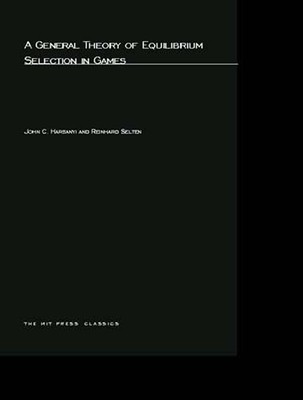
- We will send in 10–14 business days.
- Author: John C Harsanyi
- Publisher: MIT Press
- Pages: 378
- ISBN-10: 0262582384
- ISBN-13: 9780262582384
- Format: 15 x 22.6 x 2.3 cm, softcover
- Language: English
- SAVE -10% with code: EXTRA
A General Theory of Equilibrium Selection in Games (e-book) (used book) | bookbook.eu
Reviews
Description
The authors, two of the most prominent game theorists of this generation, have devoted a number of years to the development of the theory presented here, and to its economic applications. They propose rational criteria for selecting one particular uniformly perfect equilibrium point as the solution of any noncooperative game. And, because any cooperative game can be remodelled as a noncooperative bargaining game, their theory defines a one-point solution for any cooperative game as well. By providing solutions - based on the same principles of rational behavior - for all classes of games, both cooperative and noncooperative, both those with complete and with incomplete information, Harsanyi and Selten's approach achieves a remarkable degree of theoretical unification for game theory as a whole and provides a deeper insight into the nature of game-theoretic rationality. The book applies this theory to a number of specific game classes, such as unanimity games; bargaining with transaction costs; trade involving one seller and several buyers; two-person bargaining with incomplete information on one side, and on both sides. The last chapter discusses the relationship of the authors' theory to other recently proposed solution concepts, particularly the Kohberg-Mertens stability theory.
EXTRA 10 % discount with code: EXTRA
The promotion ends in 16d.15:16:29
The discount code is valid when purchasing from 10 €. Discounts do not stack.
- Author: John C Harsanyi
- Publisher: MIT Press
- Pages: 378
- ISBN-10: 0262582384
- ISBN-13: 9780262582384
- Format: 15 x 22.6 x 2.3 cm, softcover
- Language: English English
The authors, two of the most prominent game theorists of this generation, have devoted a number of years to the development of the theory presented here, and to its economic applications. They propose rational criteria for selecting one particular uniformly perfect equilibrium point as the solution of any noncooperative game. And, because any cooperative game can be remodelled as a noncooperative bargaining game, their theory defines a one-point solution for any cooperative game as well. By providing solutions - based on the same principles of rational behavior - for all classes of games, both cooperative and noncooperative, both those with complete and with incomplete information, Harsanyi and Selten's approach achieves a remarkable degree of theoretical unification for game theory as a whole and provides a deeper insight into the nature of game-theoretic rationality. The book applies this theory to a number of specific game classes, such as unanimity games; bargaining with transaction costs; trade involving one seller and several buyers; two-person bargaining with incomplete information on one side, and on both sides. The last chapter discusses the relationship of the authors' theory to other recently proposed solution concepts, particularly the Kohberg-Mertens stability theory.


Reviews